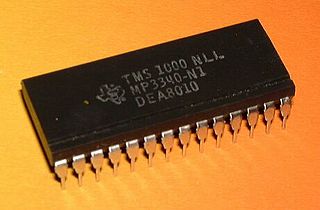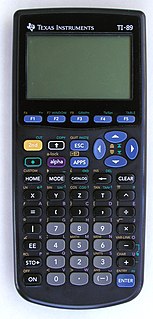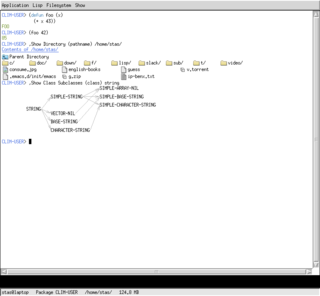
Lisp machines are general-purpose computers designed to efficiently run Lisp as their main software and programming language, usually via hardware support. They are an example of a high-level language computer architecture, and in a sense, they were the first commercial single-user workstations. Despite being modest in number Lisp machines commercially pioneered many now-commonplace technologies, including effective garbage collection, laser printing, windowing systems, computer mice, high-resolution bit-mapped raster graphics, computer graphic rendering, and networking innovations such as Chaosnet. Several firms built and sold Lisp machines in the 1980s: Symbolics, Lisp Machines Incorporated, Texas Instruments, and Xerox. The operating systems were written in Lisp Machine Lisp, Interlisp (Xerox), and later partly in Common Lisp.

A microprocessor is a computer processor where the data processing logic and control is included on a single integrated circuit, or a small number of integrated circuits. The microprocessor contains the arithmetic, logic, and control circuitry required to perform the functions of a computer's central processing unit. The integrated circuit is capable of interpreting and executing program instructions and performing arithmetic operations. The microprocessor is a multipurpose, clock-driven, register-based, digital integrated circuit that accepts binary data as input, processes it according to instructions stored in its memory, and provides results as output. Microprocessors contain both combinational logic and sequential digital logic, and operate on numbers and symbols represented in the binary number system.
Symbolics is a defunct computer manufacturer Symbolics, Inc., and a privately held company that acquired the assets of the former company and continues to sell and maintain the Open Genera Lisp system and the Macsyma computer algebra system.

Texas Instruments Incorporated (TI) is an American technology company headquartered in Dallas, Texas, that designs and manufactures semiconductors and various integrated circuits, which it sells to electronics designers and manufacturers globally. It is one of the top 10 semiconductor companies worldwide based on sales volume. The company's focus is on developing analog chips and embedded processors, which account for more than 80% of its revenue. TI also produces TI digital light processing technology and education technology products including calculators, microcontrollers, and multi-core processors. The company holds 45,000 patents worldwide as of 2016.

The TI-89 and the TI-89 Titanium are graphing calculators developed by Texas Instruments (TI). They are differentiated from most other TI graphing calculators by their computer algebra system, which allows symbolic manipulation of algebraic expressions—equations can be solved in terms of variables, whereas the TI-83/84 series can only give a numeric result.

Genera is a commercial operating system and integrated development environment for Lisp machines created by Symbolics. It is essentially a fork of an earlier operating system originating on the Massachusetts Institute of Technology (MIT) AI Lab's Lisp machines which Symbolics had used in common with Lisp Machines, Inc. (LMI), and Texas Instruments (TI). Genera was also sold by Symbolics as Open Genera, which runs Genera on computers based on a Digital Equipment Corporation (DEC) Alpha processor using Tru64 UNIX. In 2021 a new version was released as Portable Genera which runs on DEC Alpha Tru64 UNIX, x86_64 and Arm64 Linux, x86_64 and Apple M1 macOS. It is released and licensed as proprietary software.

NuBus is a 32-bit parallel computer bus, originally developed at MIT and standardized in 1987 as a part of the NuMachine workstation project. The first complete implementation of the NuBus was done by Western Digital for their NuMachine, and for the Lisp Machines Inc. LMI Lambda. The NuBus was later incorporated in Lisp products by Texas Instruments (Explorer), and used as the main expansion bus by Apple Computer and a variant called NeXTBus was developed by NeXT. It is no longer widely used outside the embedded market.
In computer architecture, 64-bit integers, memory addresses, or other data units are those that are 64 bits wide. Also, 64-bit CPUs and ALUs are those that are based on processor registers, address buses, or data buses of that size. A computer that uses such a processor is a 64-bit computer.

A digital signal processor (DSP) is a specialized microprocessor chip, with its architecture optimized for the operational needs of digital signal processing. DSPs are fabricated on MOS integrated circuit chips. They are widely used in audio signal processing, telecommunications, digital image processing, radar, sonar and speech recognition systems, and in common consumer electronic devices such as mobile phones, disk drives and high-definition television (HDTV) products.

The Space Telescope Science Institute (STScI) is the science operations center for the Hubble Space Telescope (HST), science operations and mission operations center for the James Webb Space Telescope (JWST), and science operations center for the Nancy Grace Roman Space Telescope. STScI was established in 1981 as a community-based science center that is operated for NASA by the Association of Universities for Research in Astronomy (AURA). STScI's offices are located on the Johns Hopkins University Homewood Campus and in the Rotunda building in Baltimore, Maryland.

The TI-99/4 and TI-99/4A are home computers released by Texas Instruments in 1979 and 1981, respectively. Based on the Texas Instruments TMS9900 microprocessor originally used in minicomputers, the TI-99/4 was the first 16-bit home computer, and the associated video display controller provided color graphics and sprite support that was among the best of its era.
Interlisp is a programming environment built around a version of the programming language Lisp. Interlisp development began in 1966 at Bolt, Beranek and Newman in Cambridge, Massachusetts with Lisp implemented for the Digital Equipment Corporation (DEC) PDP-1 computer by Danny Bobrow and D. L. Murphy. In 1970, Alice K. Hartley implemented BBN LISP, which ran on PDP-10 machines running the operating system TENEX. In 1973, when Danny Bobrow, Warren Teitelman and Ronald Kaplan moved from BBN to the Xerox Palo Alto Research Center (PARC), it was renamed Interlisp. Interlisp became a popular Lisp development tool for artificial intelligence (AI) researchers at Stanford University and elsewhere in the community of the Defense Advanced Research Projects Agency (DARPA). Interlisp was notable for integrating interactive development tools into an integrated development environment (IDE), such as a debugger, an automatic correction tool for simple errors (via do what I mean software design, and analysis tools.
Lisp Machines, Inc. was a company formed in 1979 by Richard Greenblatt of MIT's Artificial Intelligence Laboratory to build Lisp machines. It was based in Cambridge, Massachusetts.
Introduced in June 1976, the TMS9900 was one of the first commercially available, single-chip 16-bit microprocessors. It implemented Texas Instruments' TI-990 minicomputer architecture in a single-chip format, and was initially used for low-end models of that lineup.
Allegro Common Lisp is a programming language with an integrated development environment (IDE), developed by Franz Inc. It is a dialect of the language Lisp, a commercial software implementation of the language Common Lisp. Allegro CL provides the full American National Standards Institute (ANSI) Common Lisp standard with many extensions, including threads, CLOS streams, CLOS MOP, Unicode, SSL streams, implementations of various Internet protocols, OpenGL interface. The first version of Allegro Common Lisp was finished at the end of 1986, originally called Extended Common Lisp. Allegro CL is available for many operating systems including Microsoft Windows (32/64-bit), and many Unix and Unix-like, 32-bit or 64-bit, including macOS, Linux (32/64-bit), FreeBSD (32-bit), Solaris, UNICOS, and UTS. Internationalization and localization support is based on Unicode. It supports various external text encodings and provides string and character types based on Universal Coded Character Set 2 (UCS-2). Allegro CL can be used with and without its integrated development environment (IDE), which is available for Windows, Linux, and on macOS in version 8.2. The IDE includes development tools including an editor and an interface designer. Allegro CL can be used to deliver applications.

The Common Lisp Interface Manager (CLIM) is a Common Lisp-based programming interface for creating user interfaces, i.e., graphical user interfaces (GUIs). It provides an application programming interface (API) to user interface facilities for the programming language Lisp. It is a fully object-oriented programming user interface management system, using the Common Lisp Object System (CLOS) and is based on the mechanism of stream input and output. There are also facilities for output device independence. It is descended from the GUI system Dynamic Windows of Symbolics' Lisp machines between 1988 and 1993.
... you can check out Common Lisp Interface Manager (CLIM). A descendant of the Symbolics Lisp machines GUI framework, CLIM is powerful but complex. Although many commercial Common Lisp implementations actually support it, it doesn't seem to have seen a lot of use. But in the past couple years, an open-source implementation of CLIM, McCLIM – now hosted at Common-Lisp.net – has been picking up steam lately, so we may be on the verge of a CLIM renaissance. – From Practical Common Lisp

A microprocessor development board is a printed circuit board containing a microprocessor and the minimal support logic needed for an electronic engineer or any person that wants to become acquainted with the microprocessor on the board and to learn to program it. It also served users of the microprocessor as a method to prototype applications in products.
Daniel L. Weinreb was an American computer scientist and programmer, with significant work in the environment of the programming language Lisp.
Spacecraft Health Inference Engine (SHINE) is a software-development tool for knowledge-based systems and has been created as a product for research and development by the Artificial intelligence Group, Information Systems Technology Section at NASA/JPL to meet many of their AI goals for current and future needs. The system is now in regular use in basic and applied AI research at JPL. SHINE was developed as a system that was designed to operate in a real-time environment and to be utilized by non-LISP applications written in conventional programming languages such as C and C++. These non-LISP applications can be running in a distributed computing environment on remote computers or on a computer that supports multiple programming languages. SHINE provides a variety of facilities for the development of software modules for the primary functions in knowledge-based reasoning engines. The system may be used to develop artificial intelligence applications as well as specialized tools for research efforts.










